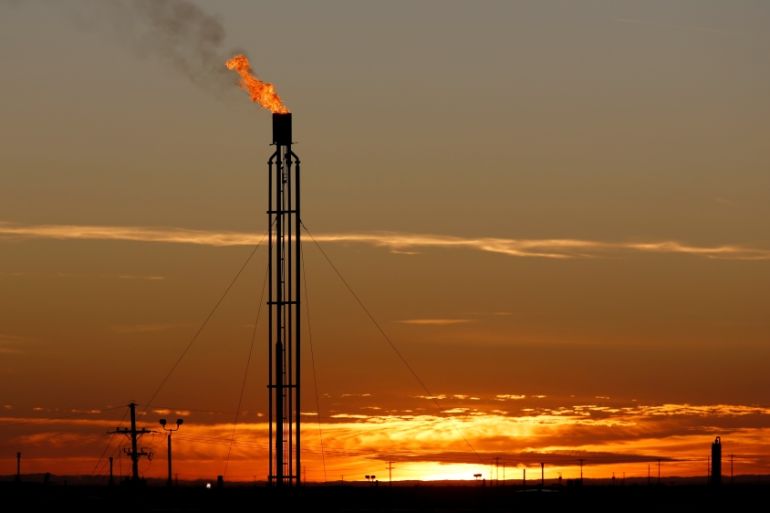Oil prices rise as storage fills up slower than expected
Shares also rose as investors found hope in countries easing their lockdowns and boosted stimulus to support economies.

US oil prices jumped on Wednesday, trimming some of this week’s losses after US stockpiles rose less than expected and on expectations that demand will increase as some European countries and United States cities moved to ease coronavirus lockdowns.
This led to a third day of gains for Asian shares as investors also took heart from easing coronavirus lockdowns in some parts of the world and continued monetary and fiscal support for economies.
Keep reading
list of 3 itemsFair share of oil production cuts: Firms haggle with governments
Oil under pressure again as storage space gets even tighter
US West Texas Intermediate (WTI) crude futures climbed to a high of $14.40 a barrel and were up 15.4 percent, or $1.90, at $14.24 at 02:33 GMT, paring a 27 percent plunge over the first two days of this week.
Brent crude futures rose 4.6 percent, or 93 cents, to $21.39 a barrel, adding to a 2.3 percent gain on Tuesday.
US crude inventories rose by 10 million barrels to 510 million barrels in the week to April 24, data from industry group the American Petroleum Institute showed on Tuesday, compared with analysts’ expectations for a build of 10.6 million barrels.
“It’s a little bit of good news that maybe storages aren’t filling quite as quickly in the US as you would have thought,” said Lachlan Shaw, head of commodity research at National Australia Bank in Melbourne.
The market will get another read on US inventories when the US Energy Information Administration releases weekly data later on Wednesday.
While storage is rapidly filling up, production cuts by US shale producers, estimated by consultants Rystad Energy at 300,000 barrels per day (bpd) for May and June, should help slow flows into tanks. The US is now the world’s biggest oil producer.
Regulators in the US state of Texas, the country’s biggest oil producer, will hold a vote on May 5 on whether to enact output curtailments. Officials in the states of North Dakota and Oklahoma are also examining ways to legally allow output cuts.
That would add to production cuts of almost 10 million bpd agreed by the Saudi Arabia-led Organization of the Petroleum Exporting Countries (OPEC) and other large producers including Russia, or about 10 percent of global production, due to take effect from May 1.
While the size of the OPEC cuts is unprecedented, demand has fallen even more and storage for all unused oil is shrinking quickly as global measures to combat the pandemic have brought many economies to a virtual standstill.
Saudi Arabia on Wednesday reported a first-quarter budget deficit of 34.107 billion Saudi riyals ($9.09bn), reversing a first-quarter surplus of about $7.4bn in 2019, as oil revenue was hit hard by a combination of sliding global prices, demand and a supply glut in the wake of the coronavirus crisis.
The kingdom – which is trying to diversify its oil-dependent economy – has projected a deficit of 187 billion riyals ($49.74bn), or 6.4 percent of gross domestic product (GDP), this year, widening sharply from 131 billion riyals ($34.84bn) last year.

Total revenues for the first quarter reached 192.072 billion riyals ($51.09bn), down 22 percent year-on-year, the finance ministry said in a statement on its website, as oil revenues dropped 24 percent.
The finance ministry said non-oil revenues were also down 17 percent to 63.3 billion riyals ($16.84bn) in the period. Total expenditures reached 226.179 billion riyals ($60.16bn), rising 4 percent from a year ago.
An International Monetary Fund official had told Reuters News Agency last year that the Gulf Arab state would need oil prices to average $85-87 a barrel this year to balance its state budget.
But credit rating agency Moody’s cut its oil price assumptions on Wednesday, seeing WTI averaging $30 a barrel in 2020 and $35 in 2021, because of a global recession weighing on fuel demand and said it expected ample oil supply in storage to keep prices low through 2021.
Shares supported
Shares and other risk assets have been mostly supported in April by heavy doses of fiscal and monetary policy stimulus around the world, aimed at softening the economic blow from the COVID-19 pandemic.
Positive news around potential treatments for the infection and a gradual easing of movement restrictions in some countries have also boosted sentiment.
These factors helped lift MSCI’s broadest index of Asia-Pacific shares outside Japan by 0.9 percent on Wednesday, having rallied 3.3 percent already this week.
Japan’s markets were closed for a public holiday.
Australian shares rose 1.2 percent led by energy and resources firms while South Korea added 1.2 percent.
Chinese markets opened in the black with the blue-chip index up 0.6 percent.
But analysts continue to predict a sharp contraction in economic growth, which will weigh on financial markets. Moody’s expects economies of the group of 20 advanced nations (G20) to shrink 5.8 percent this year with momentum unlikely to recover to pre-coronavirus levels even in 2021.
Gold, which is viewed as a safer investment in times of economic turmoil, was a touch higher on Wednesday at $1,710.61 an ounce.